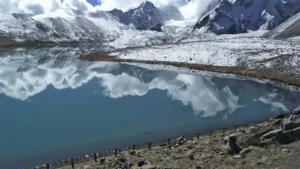Discovering the Enchanting Beauty of Sikkim: A Himalayan Paradise

Sikkim, a small yet captivating state in northeastern India, is renowned for its breathtaking landscapes, vibrant culture, and serene atmosphere. Nestled within the mighty Himalayas, this enchanting destination is a haven for nature lovers, adventure enthusiasts, and those looking to escape the hustle of urban life. This article explores the diverse attractions of Sikkim, from its stunning natural beauty to its rich cultural heritage and adventure opportunities.
A Glimpse into Sikkim
Bordered by Tibet to the north, Bhutan to the east, Nepal to the west, and West Bengal to the south, Sikkim may be one of India’s smallest states, but it boasts extraordinary biodiversity and cultural diversity. With Gangtok as its capital, Sikkim is home to some of the world’s highest peaks, including the awe-inspiring Mount Kanchenjunga, the third-highest mountain on Earth.
Natural Wonders of Sikkim
1. Majestic Mountains and Valleys
Sikkim’s landscape is dominated by towering mountains, lush valleys, and glistening rivers. The Kanchenjunga range, often enveloped in mist, offers breathtaking views. Popular trekking routes such as Dzongri La and Goechala reward travelers with panoramic vistas of snow-covered peaks.
2. Pristine Lakes
Sikkim is home to some of the most serene and picturesque lakes.
- Tsomgo Lake, located 38 km from Gangtok, is surrounded by steep mountain ranges and changes colors with the seasons.
- Gurudongmar Lake, one of the world’s highest lakes, is revered by Hindus and Buddhists and remains partially frozen during winter.
3. Rivers and Waterfalls
The Teesta and Rangeet rivers flow through Sikkim, offering thrilling opportunities for river rafting. Stunning waterfalls such as Seven Sisters Waterfall, Banjhakri Falls, and Kanchenjunga Falls further enhance the state’s natural beauty.
Sikkim’s Rich Cultural Heritage
1. Festivals and Celebrations
Sikkim’s cultural fabric is a blend of Tibetan Buddhist, Hindu, and indigenous traditions. Festivals like Losar (Tibetan New Year), Saga Dawa, and Dasain showcase the state’s rich heritage through traditional music, dance, and rituals.
2. Traditional Cuisine
Sikkimese cuisine reflects influences from Tibetan, Nepalese, and Indian flavors. Must-try dishes include momos, thukpa, and gundruk, with locally sourced ingredients like fermented bamboo shoots and Sikkimese cheese adding a unique touch.
3. Monasteries and Spiritual Sites
Sikkim is home to several ancient monasteries that serve as spiritual centers.
- Rumtek Monastery, a key center for Tibetan Buddhism, is known for its vibrant architecture and religious significance.
- Pemayangtse Monastery, one of the oldest in Sikkim, offers a glimpse into the state’s spiritual traditions.
- The annual Chaam dance, performed in monasteries, is a mesmerizing spiritual performance.
Top Tourist Attractions in Sikkim
1. Gangtok
The bustling capital city offers a mix of natural beauty and modern charm. Key attractions include MG Marg, Tashi Viewpoint, and the Namgyal Institute of Tibetology, which houses an extensive collection of Buddhist artifacts.
2. Nathula Pass
Standing at 14,140 feet, Nathula Pass serves as a historic trade route between India and Tibet. Visitors can witness the Indo-China border and enjoy spectacular mountain views.
3. Yumthang Valley
Known as the “Valley of Flowers,” Yumthang Valley bursts into color during spring, with blooming rhododendrons painting a surreal landscape.
4. Pelling
A charming town offering breathtaking views of Mount Kanchenjunga. Key attractions include Pemayangtse Monastery, Rabdentse Ruins, and the Sky Walk, which offers a thrilling glass-floor experience.
5. Zuluk
A hidden gem along the Old Silk Route, Zuluk is famous for its winding roads and stunning sunrise views over the Kanchenjunga range.
Adventure Activities in Sikkim
Sikkim is a paradise for adventure seekers, offering:
- Trekking: Popular trails like Goechala Trek and Sandakphu Trek provide exhilarating experiences.
- River Rafting: The Teesta River offers thrilling white-water rafting adventures.
- Paragliding: Fly above Gangtok’s scenic landscapes for a breathtaking aerial view.
- Mountain Biking: Explore rugged terrains and picturesque villages on a mountain bike.
Biodiversity and Conservation Efforts
Sikkim is a biodiversity hotspot, home to over 4,500 species of flowering plants, 144 species of mammals, and 550 species of birds. Rare species such as the red panda, snow leopard, and Himalayan black bear thrive here. The state has taken significant environmental initiatives, including banning plastic bags and promoting organic farming.
Best Time to Visit Sikkim
The ideal time to visit depends on your preferences:
- Spring (March–May): Best for witnessing rhododendrons and orchids in bloom.
- Summer (June–September): Ideal for trekking and experiencing lush greenery.
- Autumn (October–November): Offers clear skies and pleasant weather.
- Winter (December–February): Perfect for snowfall experiences in Lachung and Lachen.
How to Reach Sikkim
- By Air: The nearest airport is Bagdogra in West Bengal, from where taxis are available.
- By Rail: New Jalpaiguri (NJP) is the closest railway station, well-connected to major cities.
- By Road: Sikkim is accessible via well-maintained roads, with buses and taxis operating between Gangtok, Siliguri, and Darjeeling.
Sustainable Tourism in Sikkim
Sikkim is a leader in sustainable tourism, promoting eco-friendly practices such as waste management and responsible trekking. Homestays and community-led tourism provide authentic experiences while supporting local livelihoods.
Welcome to Sikkim Game
Sikkim, one of India’s most picturesque states, is a paradise for travelers seeking adventure, spirituality, and tranquility. Surrounded by towering mountains, lush valleys, and pristine lakes, this northeastern gem offers an unparalleled experience of nature’s grandeur. Despite being one of the smallest states in India, Sikkim boasts immense diversity in its landscapes, culture, and traditions.

